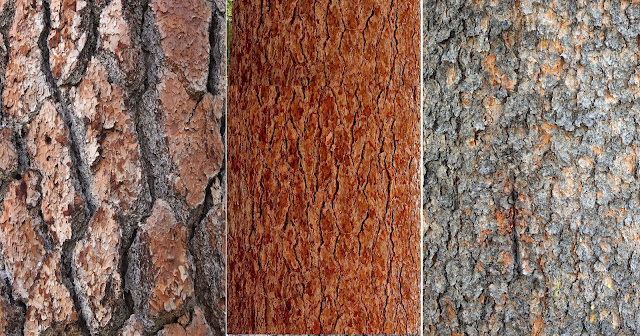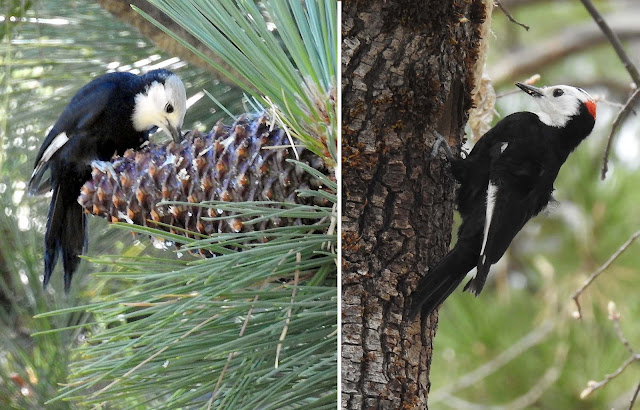
California Red Fir - Abies magnifica
The Lakes Basin is filled with conifers. You can often observe birds and mammals nesting in them, eating their cones, climbing and perching on their branches, or foraging for insects in the needles. To the casual observer the woody conifer trunk itself doesn't look inhabited. However, upon close examination, a variety of birds, insects, and fungi can be found using it! It is an ecosystem of its own!
Two different birds made me curious about what lives on tree trunks, the Brown Creeper and the Red-breasted Nuthatch. Over the years I have observed these birds foraging on tree trunks many times. I guessed that they were looking for insects in the bark crevices but wasn't sure what they were eating. The Cornell Lab of Ornithology set me straight on the types of insects that they eat, and there are LOTS of different kinds! A lot of the beetles that they eat are the ones that kill trees!
Red-breasted Nuthatch - Brown Creeper
Sitta canadensis - Certhia americana
Both of these birds live year-round in the Lakes Basin. They are small in size, approximately 5" in length, with wingspans of approximately 8". While searching for insects, the Red-breasted Nuthatch climbs, up, down and sideways on tree trunks. The Brown Creeper spirals up (not down or sideways) on tree trunks. They both also forage on tree branches. The Red-breasted Nuthatch is boldly marked and colorful, where as the Brown Creeper is camouflaged so well that on some trees it looks a piece of moving bark!
Brown Creeper - Certhia americana
The following information about Brown Creepers and Red-breasted Nuthatches is from the Cornell Lab of Ornithology at https://birdsoftheworld.org/bow.
"In winter: Animal foods include a variety of insects and larvae, spiders and their eggs, ants, and pseudoscorpions; a small amount of seeds and other vegetable matter. Breeding season: same as winter, but possibly no vegetable matter eaten . Nestlings appear to be fed only insects.
Insects include stink bugs, fruit flies, dark-winged fungus gnats, cerambicid beetles, cylindrical bark beetles, bark weevils, stem weevils, western pine beetles, red turpentine beetles, engraver beetles, and bark beetle parasitoids, lepidopterans, neuropterans, caddis flies ; weevils, leaf beetles , flat-bugs, jumping plant lice, leaf hoppers, scale insects, eggs of katydids , ants, sawflies, caterpillars, cocoons of Bucculatrix, and pupae of the codling moth, and spiders.
All year: primarily on trunks of live trees, but occasionally on large branches , sometimes on medium and small branches, and rarely on the ground and log."
Red-breasted Nuthatch - Sitta canadensis
"Animal foods include wide range of adult and larval arthropods, especially beetles, but also caterpillars, spiders, ants, sucking bugs or "leaf bugs", and flies. Plant foods include seeds of conifers, sedges, and angiosperms; also occasionally eats fruit.
Like other nuthatches, characteristically walks up or down tree trunks and large branches, probing crevices in bark for insects. Also commonly forages on small branches, probing beneath flakes of bark, at bases of needle clusters on conifer branches, and on conifer cones, where it extracts seeds. Less commonly forages in leaf litter on the ground for fallen seeds and arthropods, in rocky outcrops, and on undersides of leaves.
Like other nuthatches, regularly stores food during fall and winter. Where resident, caching of food is probably critical to overwinter survival. Caches both seeds and arthropods, although stores primarily conifer seeds. Places cached food in crevices under bark, in holes created by sapsuckers, or occasionally in the ground. Often, but not always, covers caches with small fragments of bark, lichen, or small rocks, presumably to conceal food from competitors."
 White Fir - Incense Cedar - Western White Pine
White Fir - Incense Cedar - Western White PineAbies concolor - Calocedrus decurrens - Pinus monticola
Pinus jeffreyi - Pinus lambertiana - Pinus contorta
American Square-headed Snakefly larva - Genus Negha
To my delight I found a larva right away in some pine bark! I only found one. I wasn't sure what it was so I posted a photo on inaturalist.org and they identified it as an American Square-headed Snakefly larva! Apparently these larvae live in tree bark!
Wikipedia states: "They [Snakefly larvae] may take several years before they undergo metamorphosis, requiring a period of chilling before pupation takes place. Both adults and larvae are predators of soft-bodied arthropods."
unknown spider, cobwebs, beetle wing cases
I examined about 5 trees (as far up as I could reach) and only found the one larva mentioned above, several spiders and their egg sacs, and the remains of small beetles. I am on a mission to keep looking, but so far there hasn't been a lot of insects in the bark I've examined. Maybe there are more in the summer when insects are more plentiful. Or maybe there are more insects higher up the trunk. Or maybe these birds go to lots of trees to get enough to eat! I'll keep you posted on what I find! I'm excited about learning more on this new subject!

Red-breasted Sapsucker - Syraphicus ruber
Woodpeckers are another group of birds that are usually seen on the trunks of trees. Almost all of them will eat insects off of bark, some eat tree sap, and others bore into the tree trunk to eat wood-boring beetle larvae. The Red-breasted Sapsucker pictured above is a woodpecker that hammers holes in tree bark to eat sap, not insects! As their name implies, these birds mainly eat tree sap. They drill horizontal rows of small "wells" into the bark of firs and fruit trees, and eat the sap that accumulates as well as any insects that get stuck They also eat beetles, ants, the inner bark and cambium layers of trees, fruit, and seeds. I love their bright-red head, neck, and breast! Such beauty!
White-headed Woodpecker - Picoides albolarvatus
White-headed Woodpeckers eat a variety of foods. Like Red-breasted Sapsuckers, they make sap wells, and eat sap! The wells are excavated almost exclusively in conifers, mainly pines. They also flake bark off the trunk in search for insects, primarily adult and larval insects, especially ants, beetles, scale insects, and caterpillars. They will also chisel holes in the bark to get to wood-boring beetle larvae. Additionally, they also hammer away at large pine cones to get the seeds!
Galleries of the Fir Engraver Beetle - larva - adult - Scolytus ventralis
Underneath the Bark
There are a wide variety of beetles that woodpeckers feed on underneath the bark of a tree. The type of wood-boring beetle can be determined by the shape of the larval galleries. The adult Fir Engraver Beetles, pictured above, bore through the bark and lay their eggs in horizontal grooves in the phloem of the tree. When the eggs hatch into larva, the larvae chew and form rows of galleries that are parallel to this horizontal groove. After a year the larvae pupate and emerge as adults. When a tree is infested with bark beetles, the horizontal grooves affectively girdle the tree and cut off the flow of nutrients from the needles to the roots, thus killing the tree.
Galleries of the Pink-faced Jewel Beetle with larva and adult (insets)
Buprestis lyrata
The Pink-faced Jewel Beetle is in the "Flatheaded Borers" group of wood boring beetles. The following information about Flatheaded Borers is from the website at https://extension.okstate.edu.
"Adult flatheaded borers are boat shaped, generally metallic and colorful beetles that range from 1/3 to 1 inch in length. The larvae, or grubs, are 1/4 to 2 inches long, yellowish-white, and legless with a pronounced flattened enlargement of the body just behind the head. This enlargement bears a hard plate on both the upper and lower sides. As they feed, they produce a shallow, long winding, oval gallery beneath the bark. They can sometimes damage or kill a tree by effectively girdling it, or tunneling into sapwood and heartwood. The life cycle of most flatheaded borers usually take one or two years, but some species have been known to take 25 or more years."
Holes made by Pileated Woodpeckers in search of wood-boring beetle larvae
insets: adult and larva of longhorned beetles
Another group of wood-boring beetles are the "Round Headed Borers", also known as Longhorned Beetles. The following information about Longhorned Beetles is from the website at https://mdc.mo.gov/discover-nature/field-guide/longhorned-beetles-borers-sawyer-beetles.
"There are about 1,000 species of Longhorned Beetles in North America north of Mexico. Each species of this large and diverse group of wood boring beetles is usually found near its special type of host tree, host plant, or dead wood. The larvae are usually found in dead, sick, or living trees. Some feed under the bark, where a tree’s vascular tissues are concentrated. Others bore deep into the trunk or roots, where they eat damp wood to survive. Adults eat various foods, including flowers, leaves, bark, fungi, and sap. Some adults only take water.
Lifespans range from a few months to decades, but most live 1–3 years. After mating, females seek out the appropriate food plant, usually a tree, in the appropriate stage of life, sickness, or decomposition, and deposit eggs into the wood. The larvae hatch and burrow into the tree, eating it and making tunnels in the process. Most of the longhorn’s life is spent in the larval stages. After pupating, adult beetles chew their way out of the wood and seek mates to continue the cycle.
Our native longhorns are an important part of forest ecosystems. Their burrowing into dead or dying wood helps recycle nutrients into the soil."
Pileated Woodpecker (male) - Dryocopus pileatus
Pileated Woodpeckers chisel and peck all the way through the bark and into the heartwood to get wood boring insect larvae. They will listen at the trunk to hear the larvae inside! They are large woodpeckers with large bills. They have long, barbed tongues that can travel through a larval tunnel, pierce the larva, then withdraw it from the trunk! The dead trees pictured above have lots of holes made by a Pileated Woodpeckers searching for beetle larvae. However, a Pileated Woodpecker's favorite food is carpenter ants! They also eat thatching ants, termites, and miscellaneous insects and berries.
Fungi and bird nests are additional aspects of the tree trunk ecosystem!
Check back in two weeks to find out more about them, and much more!
After 8 years of posting my blog, I've decided that I'm only going to post my blog twice monthly from now on. My next post will be on the weekend of September 28th. See you then!
Your questions and comments are always appreciated. Please email me at northyubanaturalist@gmail.com. Thanks!












No comments:
Post a Comment